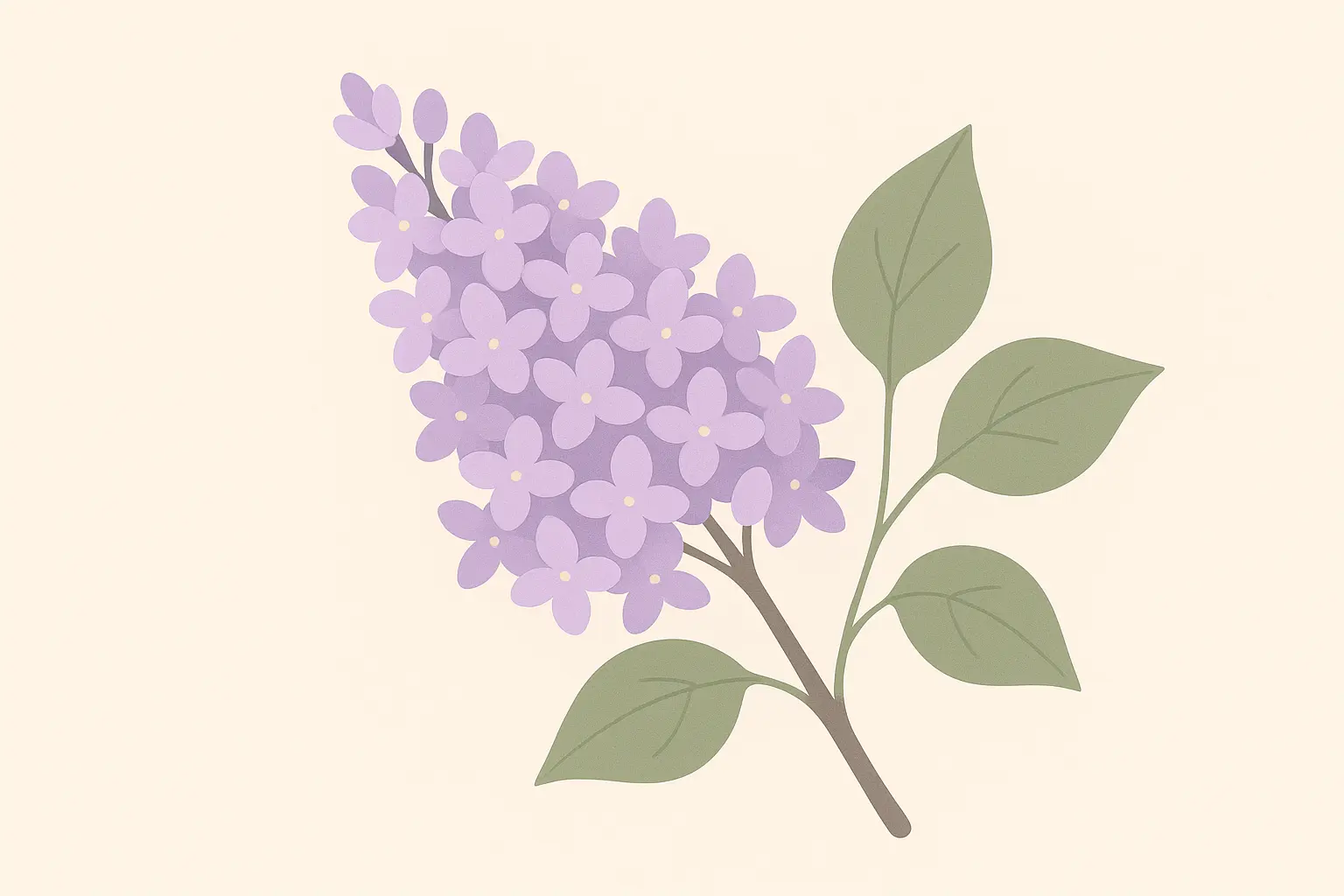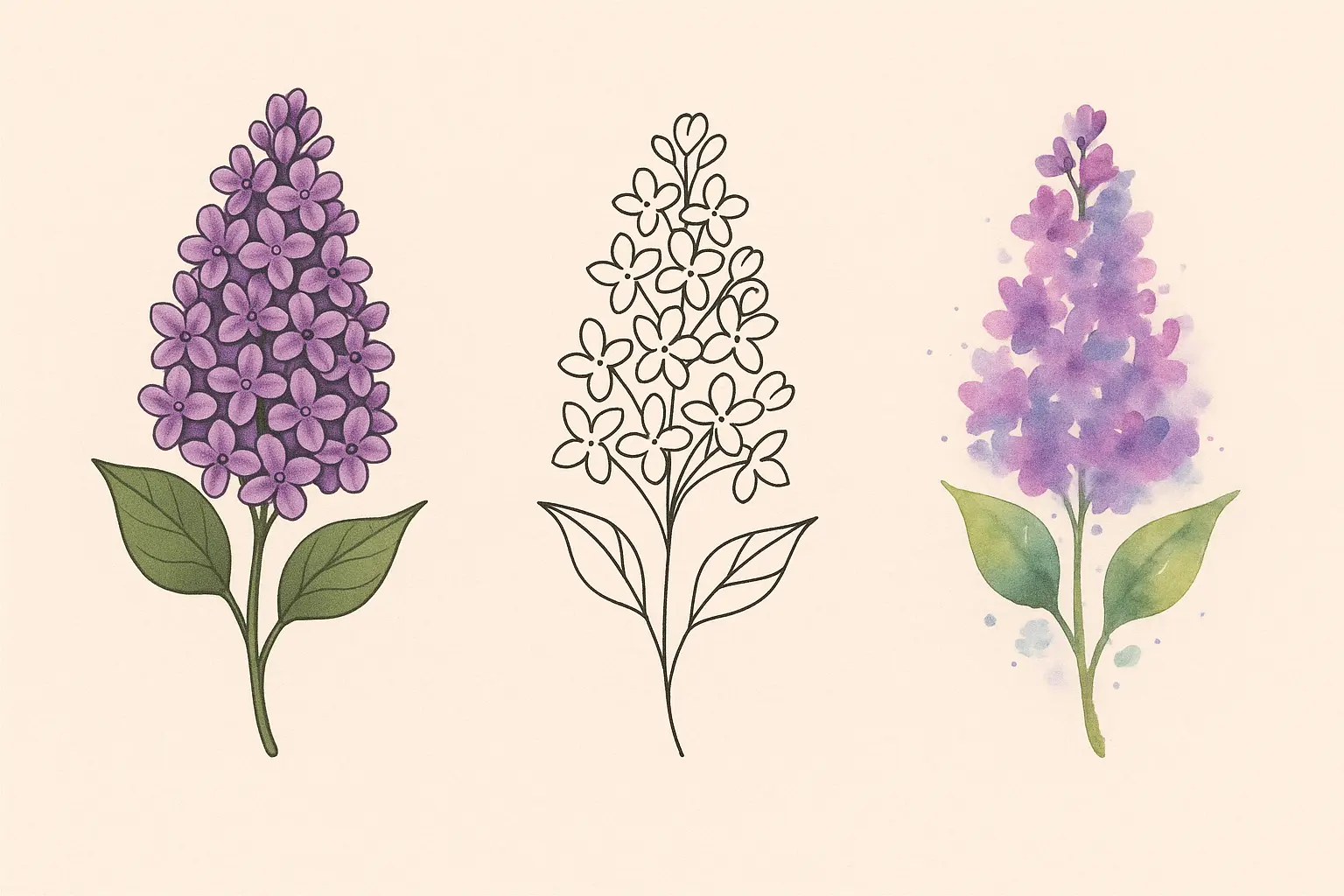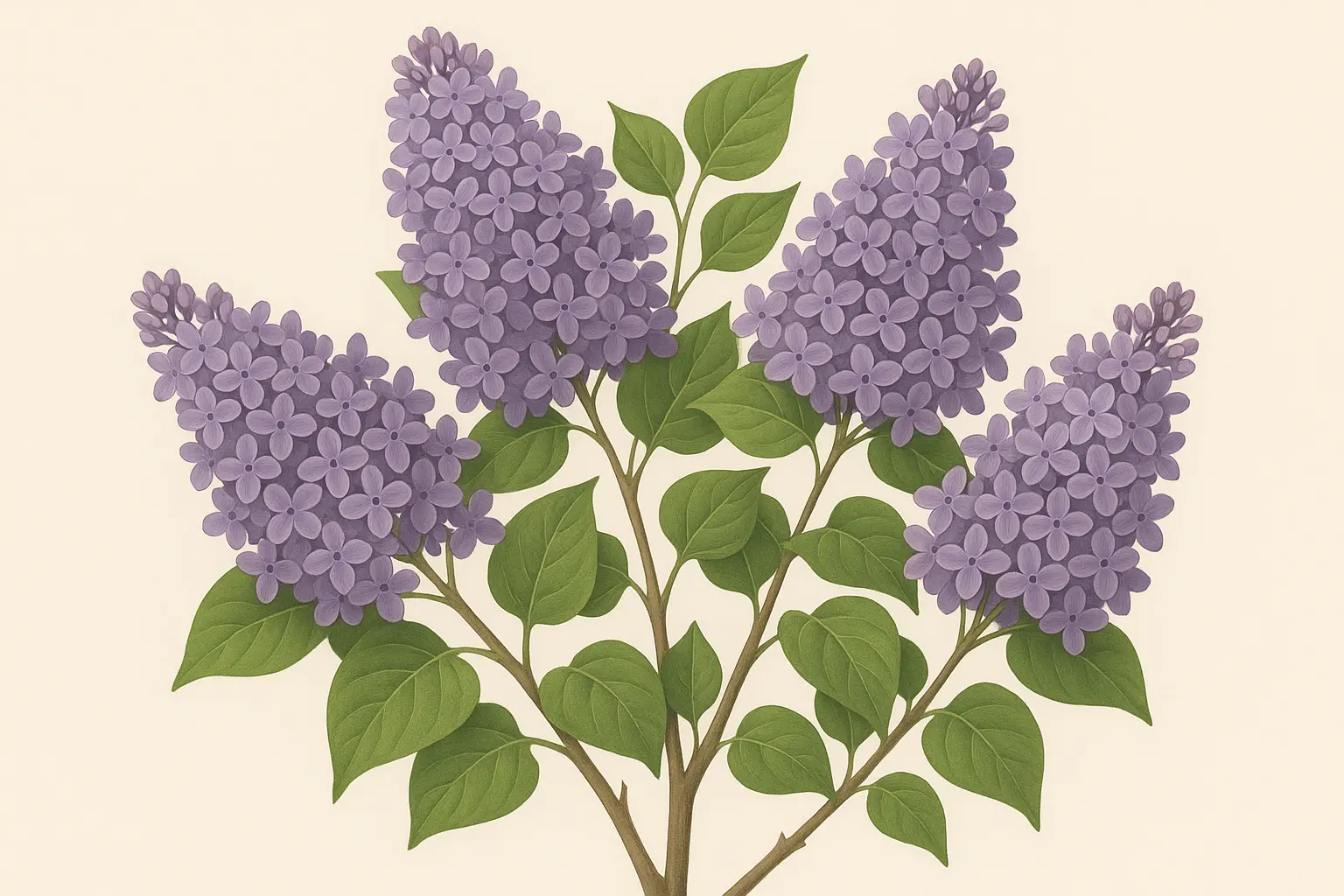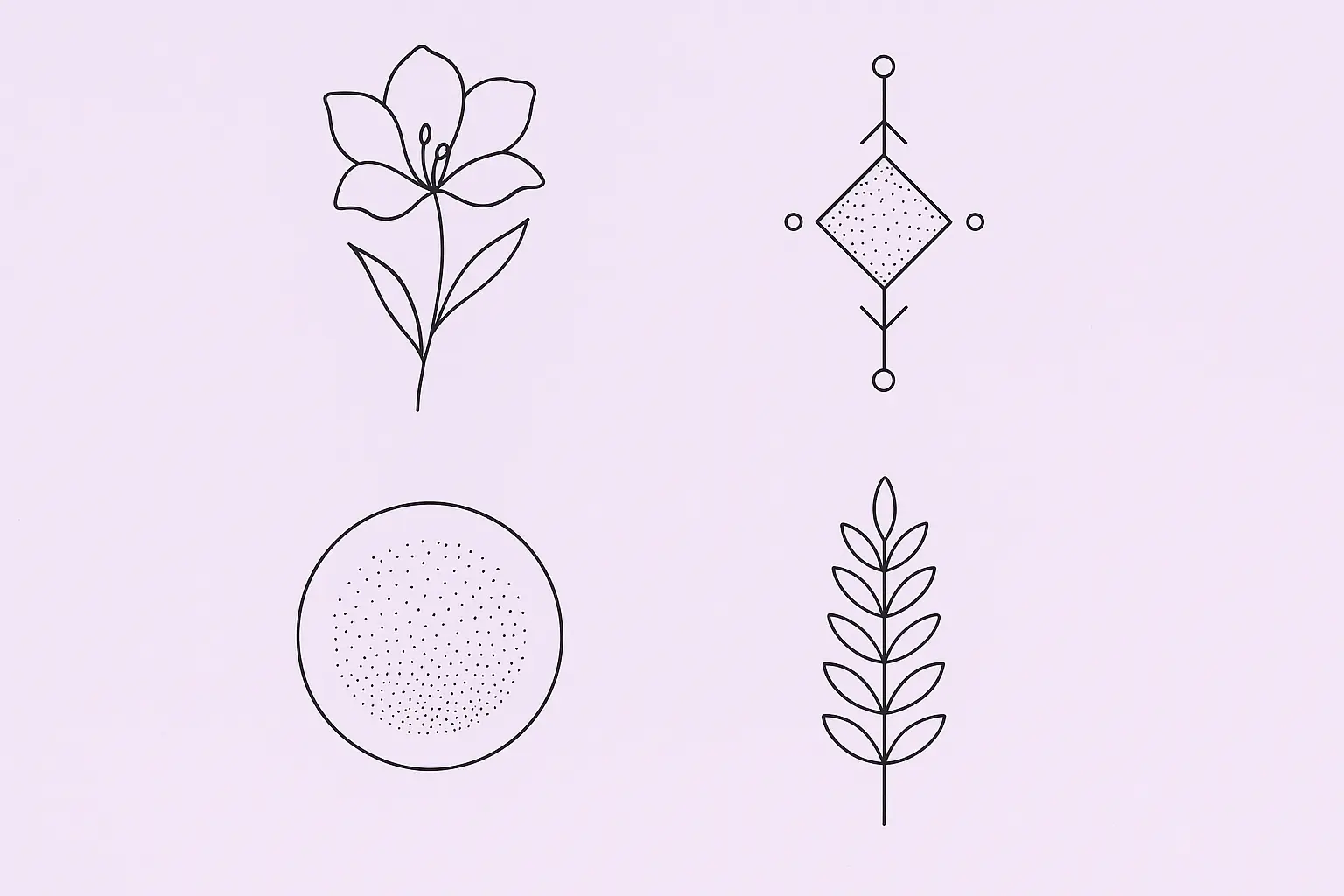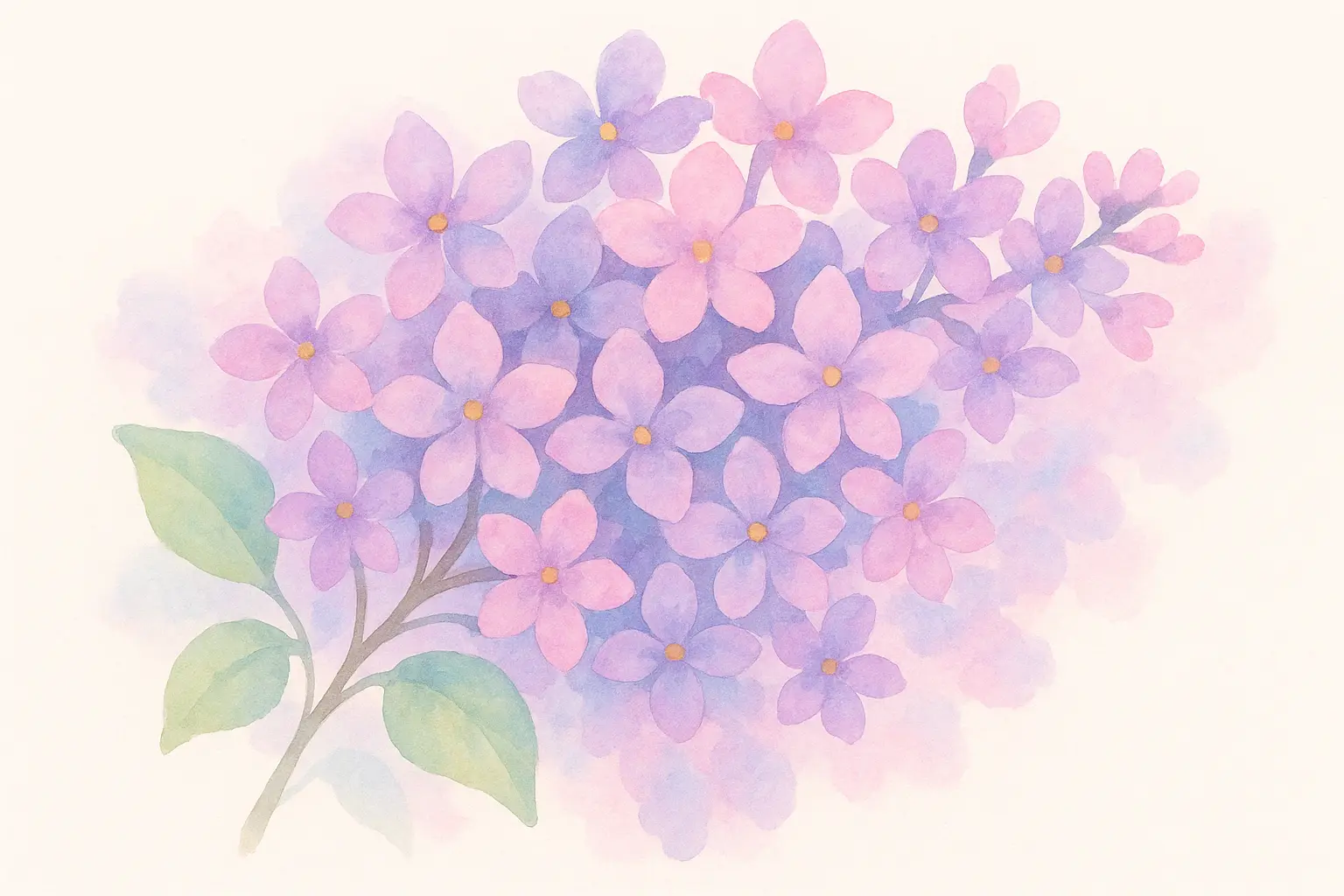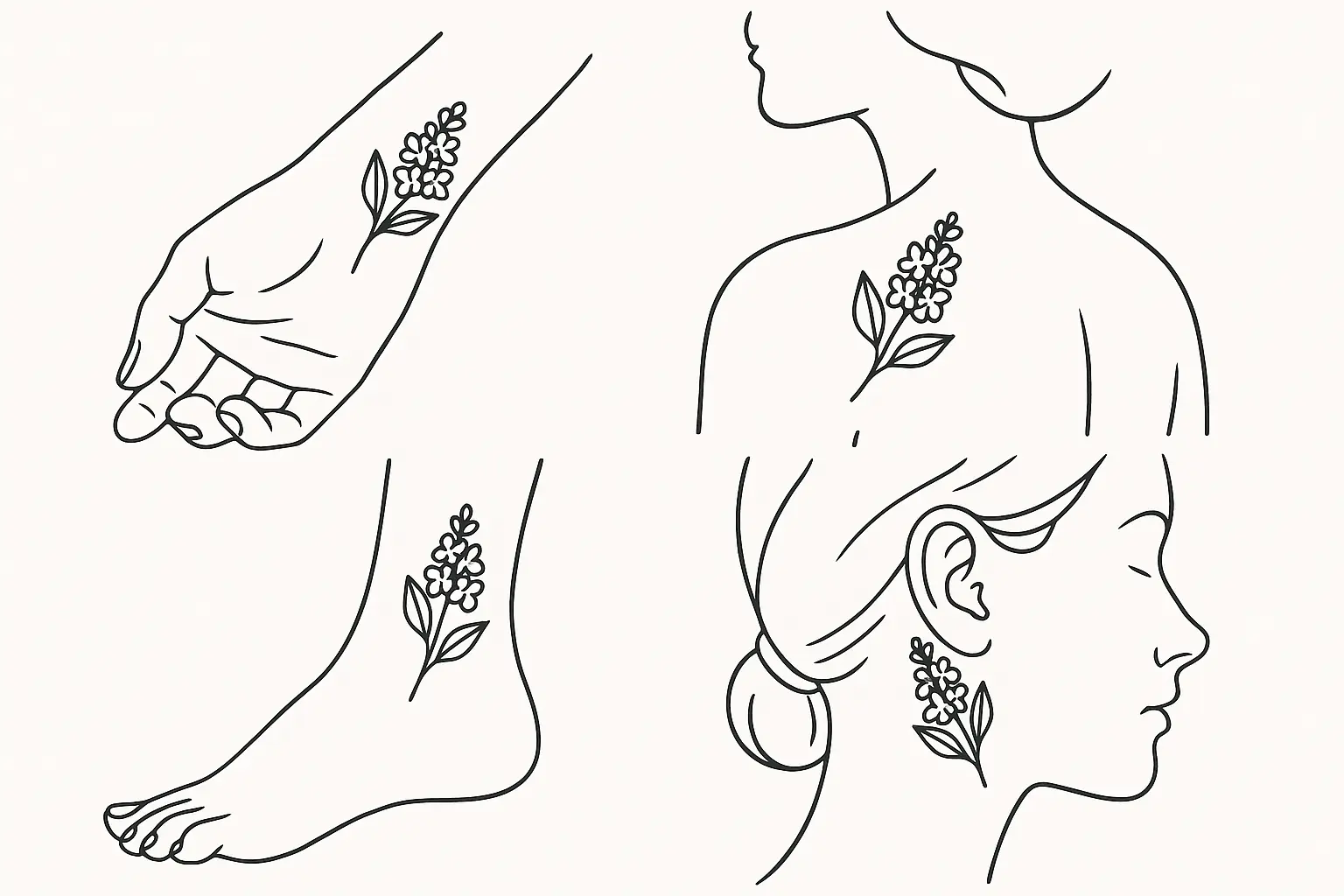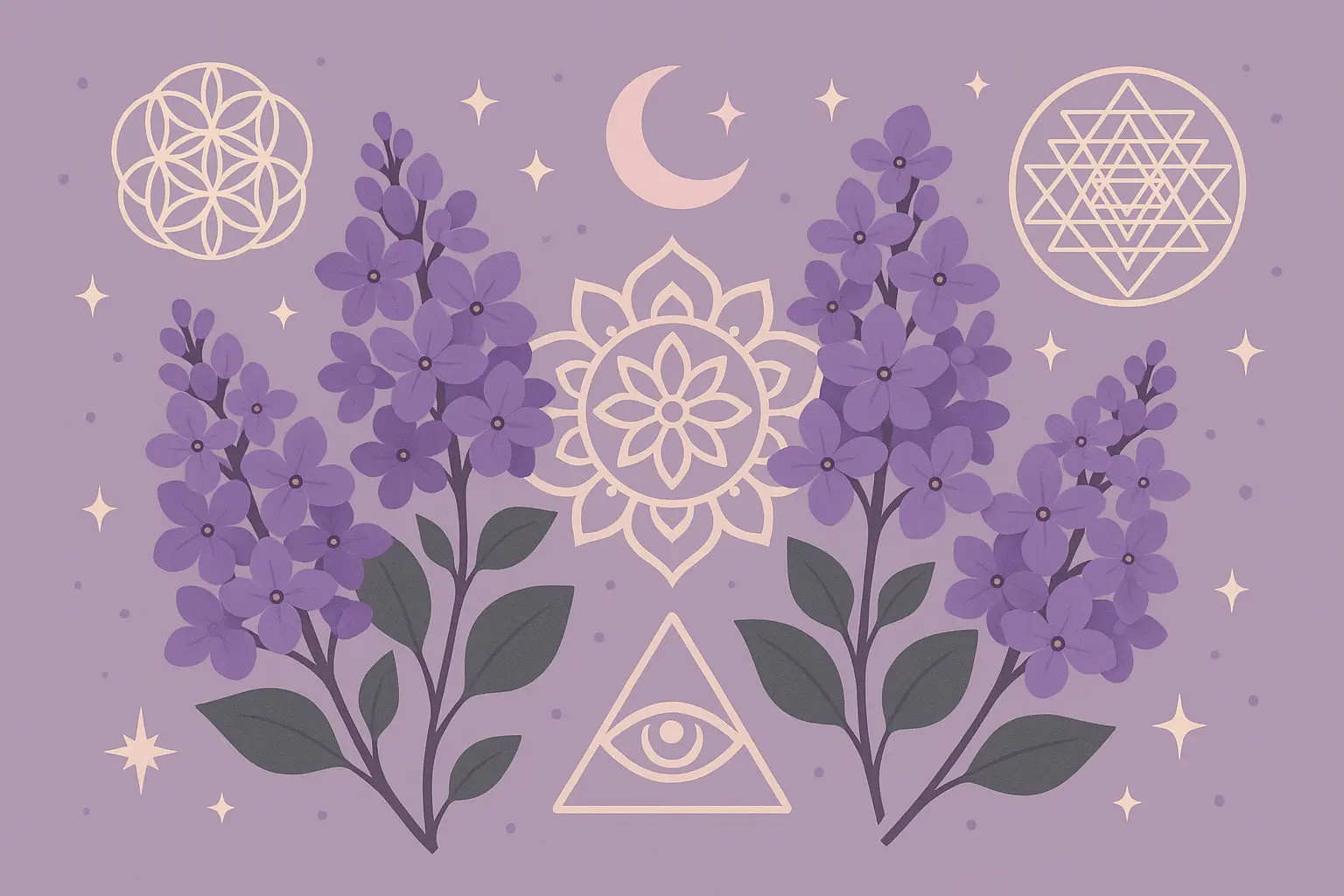25 Stunning Lilac Tattoo Designs That Will Transform Your Body Art Vision
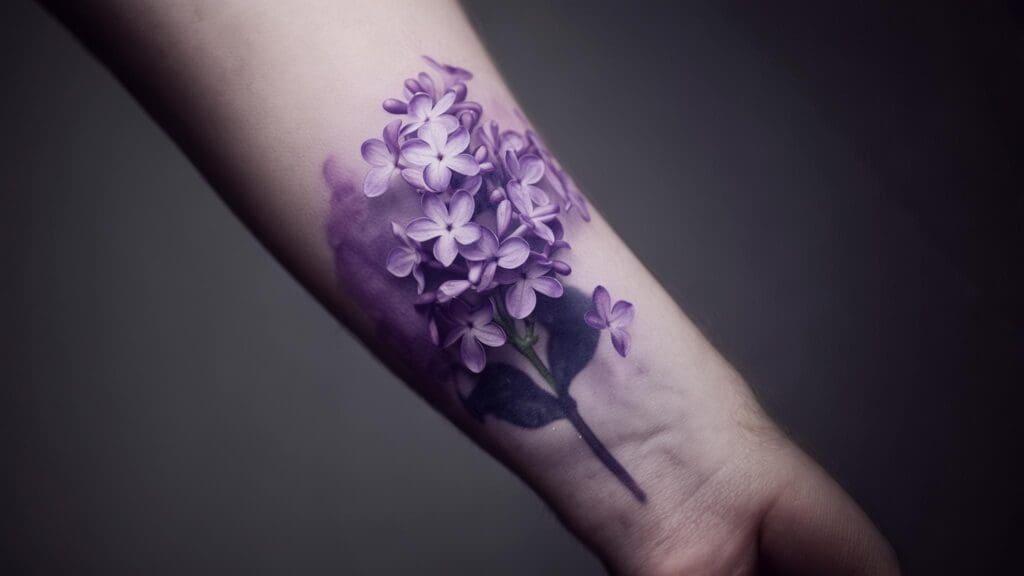
I’ve been seeing lilac tattoos everywhere lately, and honestly? I get it. I still remember discovering my first lilac bush during a spring walk—the cascading purple blooms seemed to hold secrets of renewal and fleeting beauty that stayed with me long after the petals fell. Today, that same enchantment draws countless people to lilac tattoo designs, seeking to capture both the flower’s visual appeal and its profound symbolic meaning.
These enchanting designs have evolved way beyond simple botanical illustrations. Modern lilac tattoos celebrate femininity, spirituality, and life’s most precious moments through sophisticated artistic statements. Whether you’re drawn to photorealistic bouquets or prefer clean minimalist lines, this guide will help you explore 25 lilac tattoo ideas to find your perfect design.
Source: SocialBlade Instagram Analytics
Table of Contents
-
Things to Consider Before Getting Your Lilac Tattoo
-
Realistic and Botanical Lilac Tattoos (Designs 1-5)
-
Minimalist and Line Art Designs (Designs 6-10)
-
Colorful and Vibrant Styles (Designs 11-15)
-
Placement-Specific Designs (Designs 16-20)
-
Symbolic and Meaningful Variations (Designs 21-25)
-
What Actually Works Long-Term
-
Making Sure It Fits Your Life
-
Common Mistakes to Avoid
-
Final Thoughts
TL;DR
-
Lilac tattoos represent first love, spiritual awakening, and life’s fleeting beauty—but make sure that actually resonates with you
-
Five main styles: realistic botanical, minimalist line art, vibrant colorful, placement-specific, and symbolic meaningful designs
-
Think about your job and lifestyle before choosing placement—some spots are easier to hide than others
-
Simple black line work ages best while complex color pieces will need touch-ups
-
Budget anywhere from $100-300 for simple designs to $800-2000+ for elaborate realistic pieces
-
Purple ink can be tricky and may fade unevenly, so choose your artist carefully
Things to Consider Before Getting Your Lilac Tattoo
Look, I’ve seen too many people rush into floral tattoos without thinking it through. Before you fall in love with a design, let’s talk about some real considerations that’ll save you regret later.
First up—do lilacs actually mean something to you, or do you just think they’re pretty? There’s nothing wrong with getting a tattoo just because you love how it looks, but be honest about it. I’ve met people who got lilacs because they read about the symbolism online, then realized they didn’t actually connect with any of it.
What Lilacs Actually Symbolize (And Why It Matters)
Purple lilacs traditionally represent first love and youthful emotions, while white varieties symbolize innocence and new beginnings. In Victorian flower language, these blooms conveyed messages of spiritual awakening and life’s ephemeral nature.
But here’s the thing—what draws YOU to lilacs specifically? Your personal connection is what determines whether this tattoo will still feel meaningful in ten years. Some people choose lilacs to honor childhood memories of their grandmother’s garden. Others connect with themes of renewal after going through major life changes.
|
Lilac Color |
What It Traditionally Means |
Real Talk |
Best For |
|---|---|---|---|
|
Purple |
First love, youthful passion |
Pretty classic, works for most people |
Memorial tattoos, anniversary pieces |
|
White |
Innocence, purity, new beginnings |
Can be hard to see on lighter skin |
Birth celebrations, fresh starts |
|
Pink |
Grace, femininity, admiration |
Sweet but maybe too cutesy for some |
Mother-daughter tattoos, friendship bonds |
|
Lavender |
Serenity, calmness, devotion |
Trendy right now but timeless enough |
Meditation reminders, calming vibes |
Placement Reality Check
Your tattoo’s placement affects everything from how much it hurts to whether you can keep your job. Behind-the-ear designs are cute and easy to hide with your hair, but they hurt more than people tell you. Shoulder pieces give you room for detail and look great, but you’ll see them every day—make sure you really want that constant reminder.
Think about your career situation. Healthcare, education, and a lot of corporate jobs still aren’t cool with visible tattoos. I know someone who had to wear long sleeves for two years at her banking job because she got a gorgeous forearm piece without thinking it through. Creative industries and tech companies are way more relaxed, but even then, it depends on your specific workplace.
Understanding tattoo placement is crucial, especially when considering pain levels across different body areas as detailed in our comprehensive pain level tattoo chart.
Sarah, a nurse I know, chose a delicate lilac sprig behind her ear that she can easily hide with her hair during shifts. When she’s off work, she can show it off or keep it hidden depending on her mood. Three years later, she still loves the flexibility.
Style Choices That Actually Matter
Realistic botanical illustrations look incredible when they’re fresh, but they require an artist who really knows their stuff. If you go cheap on a realistic piece, you’ll regret it. Simple line work is more forgiving and ages beautifully, but some people find it too minimalist.
Watercolor techniques are gorgeous and very Instagrammable, but they fade faster than traditional tattoos. You’ll probably need touch-ups every few years to keep them looking vibrant.
Size and Complexity—Be Realistic
Lilac clusters work great in different sizes, from tiny single sprigs to elaborate garden scenes. But here’s what nobody tells you: if you go too small with a detailed design, it’ll turn into a blob as it ages. Your artist should be honest about what level of detail will actually work at your chosen size.
Bigger pieces cost more and take longer, obviously. But they also hurt more because you’re sitting for hours. Be realistic about your pain tolerance and budget. It’s better to start with something smaller that you can afford to do well than to compromise on quality for a bigger piece.
Color Considerations (The Honest Version)
Traditional purple and white lilac combinations look classic and timeless. Black and white versions age better and cost less to touch up. But let’s talk about purple ink specifically—it can be tricky. Some people’s skin doesn’t hold purple well, and it can fade to a muddy brownish color over time.
Different ink colors age differently on different skin types. If you have darker skin, white ink might barely show up. If you have very fair skin, some purples might look too bold. A good artist will help you choose colors that work with your skin tone and aging expectations.
Realistic and Botanical Lilac Tattoos
Realistic lilac tattoos are gorgeous when done right, but they’re not for everyone. These designs require serious artistic skill and a decent budget. If you’re thinking about going this route, don’t cheap out on the artist—botanical realism is one of those things where the difference between good and great is huge.
The five designs in this category range from single branches to full bush compositions. They’re impressive and make great conversation pieces, but they also require the most maintenance and the biggest upfront investment.
1. Photorealistic Lilac Branch
This is the holy grail of lilac tattoos—a branch that looks like you could pluck it right off your skin. Every petal, leaf, and shadow is captured in detail. It’s seriously impressive when done well, but it requires an artist who specializes in botanical realism.
Perfect for people who want their tattoo to be a genuine work of art. You need at least 4 inches of space to do this style justice, so think shoulder, thigh, or back placement.
The downside? It’s expensive (we’re talking $500-1500 depending on size), takes multiple sessions, and requires an artist with serious botanical illustration skills. But when it’s done right, people will literally stop you on the street to ask about it.
2. Lilac Bush Corner Piece
A full lilac bush design that flows around your shoulder, thigh, or back. This is for people who want to go big and aren’t afraid of commitment. The design incorporates multiple bloom clusters and natural branching patterns.
This style works great if you want to cover an old tattoo or scar. You can also add personal touches like different bloom stages to represent family members or life phases.
Fair warning: this is a major time and money investment. We’re talking multiple sessions over several months and costs that can easily hit $2000+. But if you want dramatic impact and have the budget for it, this is incredibly striking.
3. Single Lilac Sprig Portrait
A more manageable realistic option—one detailed stem with flowers and leaves. You still get that botanical accuracy and artistic sophistication, but in a size that won’t break the bank or require months of sessions.
This is a great entry point if you want realistic work but aren’t ready for a huge commitment. It works beautifully in smaller spaces and can always be expanded later if you decide you want more. For those considering their first tattoo, exploring our collection of simple tattoo ideas can provide additional inspiration for minimalist approaches.
Cost-wise, you’re looking at $200-600 depending on size and detail level. It ages well, and you have lots of placement options.
4. Lilac Bouquet Composition
Multiple stems arranged like a bouquet, sometimes with ribbon or other decorative elements. This plays into the traditional romantic associations with lilacs and gives you room for creative color variation.
Bouquets work great on forearms or thighs where you can display the full arrangement. You can play with different purple shades to add visual interest while keeping the design cohesive.
This is moderately complex—more involved than a single sprig but not as intense as a full bush. Expect to spend $400-800 and plan for 2-3 sessions depending on size and color complexity.
5. Watercolor Realistic Hybrid
This combines realistic lilac details with watercolor background effects. It’s very trendy right now and looks amazing on social media, but let’s be real about the maintenance.
Watercolor elements fade faster than traditional tattoo work. You’ll probably need touch-ups every 3-5 years to keep it looking vibrant. Some people love this and don’t mind the upkeep; others find it annoying.
If you love the look and don’t mind periodic maintenance, go for it. Just budget for those touch-ups from the start. The initial cost is similar to other realistic work ($400-1000), but factor in $100-200 every few years for maintenance.
Minimalist and Line Art Designs
Honestly, minimalist lilac tattoos are probably your best bet if you want something that’ll still look great in 20 years. These designs focus on clean lines and simple elegance rather than complex details. They’re also way more budget-friendly and heal faster.
The five designs in this category prove that simple doesn’t mean boring. From single-line masterpieces to geometric interpretations, these options offer sophistication without the high maintenance of realistic work.
6. Simple Lilac Line Drawing
Clean, continuous lines that capture the essence of lilacs without getting bogged down in details. This is timeless, elegant, and works in professional environments where you need something subtle.
The beauty of line work is that it ages gracefully. While realistic tattoos might lose some detail over time, good line work stays crisp for decades with proper care.
You’re looking at $100-300 for most line work pieces, and they heal quickly. Perfect if you want something meaningful but not overwhelming.
Marcus, a software developer, got a simple line drawing of a lilac branch on his forearm. Three years later, it still looks exactly like it did when he got it—clean, professional, and timeless.
7. Geometric Lilac Silhouette
This combines natural lilac shapes with geometric elements like triangles or hexagons. It’s modern and appeals to people who work in tech or design fields where clean, structured aesthetics are appreciated.
The geometric aspect makes it feel contemporary while the lilac keeps it feminine and natural. It’s a nice compromise if you want something that feels current but won’t look dated in ten years. Those drawn to geometric elements might also appreciate our comprehensive guide to geometric tattoo designs for additional inspiration.
Cost is similar to other line work—$150-400 depending on complexity and size.
8. Dotwork Lilac Cluster
Uses tiny dots (stippling) to create lilac flowers instead of solid lines or shading. It creates beautiful texture and depth while maintaining that minimalist aesthetic.
Dotwork requires an artist with specific skills, so make sure your tattoo artist actually knows this technique. When done well, it creates subtle sophistication that reveals new details when people look closer.
Expect to pay a bit more than simple line work ($200-500) because dotwork is time-intensive, but it ages exceptionally well.
9. Single Line Lilac Branch
This is the ultimate minimalist challenge—creating an entire lilac branch with flowers and leaves using one continuous line. It requires serious artistic skill and looks incredibly sophisticated.
The single-line approach is perfect for professional environments. It’s subtle enough that some people might not even realize it’s a tattoo at first glance, but those who look closer will appreciate the artistic skill involved.
You need an artist who’s really good at line work for this to look right. Done well, it’s stunning. Done poorly, it just looks like a mistake.
10. Abstract Lilac Interpretation
This captures the feeling of lilacs through simplified shapes and strategic line placement rather than trying to make them look exactly like real flowers. It’s artistic and personal—the meaning might not be immediately obvious to others.
Abstract work allows for highly personal interpretation. Your lilac tattoo becomes a symbol that holds special meaning for you while maintaining artistic beauty.
The challenge with abstract work is making sure it still reads as “lilac” to you, even if others don’t immediately recognize it. Spend time with your artist to get the balance right between abstraction and recognition.
Colorful and Vibrant Styles
Colorful lilac tattoos are eye-catching and photograph beautifully, but let’s talk honestly about what you’re signing up for. Vibrant colors look amazing when they’re fresh, but they require more maintenance than black and gray work. Purple ink, specifically, can be unpredictable—it might fade to a muddy brown on some skin types.
That said, if you’re willing to do the upkeep and you’ve found an artist who’s great with color, these designs can be absolutely gorgeous.
11. Traditional Purple Lilac Cluster
Classic lilacs in their natural purple color with realistic shading and highlights. This is what most people picture when they think “lilac tattoo,” and there’s a reason it’s popular—it works.
Traditional purple maintains that authentic connection to the actual flower. It’s recognizable, timeless, and most people find it appealing. Just make sure your artist uses high-quality purple ink and knows how it ages on your skin type.
You’re looking at $300-600 for a good-sized cluster, and you’ll probably want a touch-up in 5-7 years to keep the colors vibrant.
12. White Lilac Elegance
White lilacs emphasize themes of purity and new beginnings, but white ink comes with challenges. On darker skin tones, it might barely show up. On very fair skin, it can look more prominent than expected.
White ink also tends to yellow over time, especially if you spend a lot of time in the sun. Some people love the subtle, almost ethereal look, while others find it too faint to be satisfying.
Talk to your artist about realistic expectations for white ink on your specific skin tone. You might want to consider off-white or very light purple instead of pure white.
|
Tattoo Style |
Cost Range |
Session Time |
How Much Upkeep |
Best Placement |
|---|---|---|---|---|
|
Simple Line Work |
$100-300 |
1-2 hours |
Minimal |
Wrist, ankle, behind ear |
|
Realistic Color |
$400-800 |
3-5 hours |
Touch-ups every 5-7 years |
Shoulder, thigh, back |
|
Watercolor |
$300-600 |
2-4 hours |
Touch-ups every 3-5 years |
Forearm, shoulder, back |
|
Minimalist |
$150-400 |
1-3 hours |
Very little |
Any placement |
|
Memorial/Symbolic |
$250-800 |
2-5 hours |
Depends on style |
Personal preference |
13. Multicolored Lilac Fantasy
This is where you can get creative with non-natural colors like blues, pinks, or sunset gradients. It’s artistic and lets you create something completely personal, but it also means you’re moving away from the traditional symbolism of lilacs.
Fantasy colors let you match your tattoo to your personal style rather than being limited by what lilacs actually look like. Some people love this freedom; others prefer to stick with natural colors.
Just remember that unusual color combinations might not age as predictably as traditional purples. Your artist should be honest about how different pigments will look in 10 years.
14. Pastel Watercolor Lilacs
Soft, dreamy watercolor technique using pastel purples, pinks, and blues. It’s very feminine and romantic, and it photographs beautifully for social media.
But here’s the reality check: watercolor tattoos are high maintenance. The soft, blended edges that make them so pretty also make them fade faster than traditional work. You’re signing up for regular touch-ups.
If you love the look and don’t mind the upkeep, go for it. Just budget for maintenance from the start and find an artist who’s genuinely skilled at watercolor techniques—not all tattoo artists are.
15. Sunset Lilac Silhouette
Lilac silhouettes against colorful sunset backgrounds. This combines floral elements with landscape artistry and tells more of a story than just flowers alone.
The sunset background adds drama and can represent specific memories or feelings. Maybe you want to capture that perfect spring evening when you decided to get the tattoo, or honor a special place where lilacs grow.
This is complex color work that requires a large canvas to look right. Think shoulder blade, thigh, or back placement. It’s beautiful but expensive—expect to pay $600-1200+ depending on size and detail.
Placement-Specific Designs
Different body areas work better for different types of lilac designs. Here’s the real talk about five popular placement options, including what hurts, what’s practical, and what looks good long-term.
16. Behind-the-Ear Lilac Sprig
A delicate small design that’s perfect for people who want something subtle and easily hidden. You can show it off when you want to or hide it completely with your hair.
But let’s be honest about the downsides: behind-the-ear tattoos hurt more than people expect. The skin is thin and close to bone. Also, this area can be tricky to heal properly because hair products and pillowcases can irritate it.
That said, if you want something small and professional-friendly, this placement works great. Just be prepared for a more uncomfortable tattooing experience than, say, your forearm.
17. Wrist Wrap Lilac Vine
A lilac vine that wraps around your wrist like a bracelet. It’s visible daily, which can be either a pro or con depending on your perspective and job situation.
Wrist tattoos get a lot of wear and tear from hand washing, sleeves rubbing, and general daily use. You might need touch-ups more frequently than tattoos in protected areas.
Also consider that wrist tattoos are hard to hide. If your job requires conservative appearance, this might not be the best choice. But if you work somewhere flexible and want a daily reminder of your tattoo’s meaning, it’s lovely.
18. Shoulder Cascade Lilac Design
A larger piece that flows over your shoulder, often extending onto your upper arm or back. This placement gives you room for detail while following your body’s natural lines.
Shoulders are great for tattoos—the pain is manageable, the area heals well, and you can easily show it off or cover it up depending on your outfit. Plus, shoulder tattoos tend to age well because the skin doesn’t stretch much in that area.
The main consideration is cost and time. Larger pieces mean more sessions and higher prices. For those considering shoulder placement, our detailed guide on shoulder tattoo costs can help with budget planning.
19. Ankle Lilac Accent
Small to medium lilac designs around the ankle area. This placement offers seasonal visibility—you can show it off in summer with sandals and shorts, then keep it covered during professional winter months.
Ankle tattoos can be a bit more painful than expected because there’s not much cushioning between the needle and bone. They also fade faster than tattoos in protected areas because socks and shoes create friction.
If you love the idea of seasonal visibility and don’t mind potential touch-ups, ankle placement can be really cute and feminine.
20. Ribcage Lilac Garden
A larger, more elaborate design along your ribcage. This is completely private—you choose who sees it and when. It’s perfect for meaningful, personal tattoos that you don’t need to share with the world.
Fair warning: ribcage tattoos hurt. A lot. The skin is thin, it’s close to bone, and you’re sitting for a long time in an awkward position. But the privacy can be worth it if you want something elaborate and personal.
This placement works great for memorial pieces or designs with deep personal meaning that you want to keep private.
Symbolic and Meaningful Variations
These five designs go beyond just looking pretty—they incorporate deeper meaning and personal significance. If you’re getting a tattoo to commemorate something important or as a reminder of personal growth, these approaches might resonate with you.
21. Memorial Lilac Tribute
Lilac designs that honor someone you’ve lost, often incorporating dates, names, or other memorial elements. Lilacs’ natural association with remembrance makes them perfect for this purpose.
Memorial tattoos can be incredibly healing during the grief process. They provide a way to carry someone’s memory with you while creating something beautiful from loss.
Think carefully about what elements to include. Dates and names are obvious choices, but you might also consider incorporating the person’s favorite quote, a symbol that represents them, or even their handwriting if you have a sample.
Jessica got a memorial lilac tattoo with her grandmother’s birth and death dates woven into delicate vine work. The purple blooms represent their shared love of gardening, and the flowing design reminds her that her grandmother’s influence continues in her life. She says it brings comfort during difficult moments and helps her feel connected to her grandmother’s memory.
22. Mother-Daughter Lilac Connection
Matching or complementary lilac designs shared between mothers and daughters. This creates a special bond and shared experience while allowing for individual interpretation.
You might choose the same basic design in different sizes, or complementary designs that go together—like a mother lilac bush and daughter sprig. Different bloom stages can represent different life phases or the relationship between generations.
These work best when both people genuinely want the tattoo, not when one person is pressuring the other. Make sure you’re both committed to the idea and have realistic expectations about the process. For more inspiration on family bonding tattoos, explore our collection of mom daughter tattoo ideas that celebrate these special relationships.
23. Spiritual Awakening Lilacs
Lilac designs combined with spiritual symbols like mandalas, lotus elements, or sacred geometry. This approach appeals to people on spiritual journeys who want their tattoo to serve as a daily reminder or meditation focus.
The combination of natural beauty with spiritual symbolism can create powerful personal meaning. Just make sure you understand the spiritual symbols you’re incorporating—don’t just add them because they look cool.
Consider how these elements will work together visually and symbolically. The best spiritual tattoos feel cohesive rather than like random symbols thrown together.
24. Seasonal Cycle Lilac Design
A comprehensive design showing lilacs through different seasonal stages—budding spring growth, full summer bloom, autumn fade. This celebrates natural cycles and life’s transitions.
This approach tells a complete story about growth, change, and the cyclical nature of life. It appeals to people who find meaning in natural patterns and seasonal changes.
The challenge is creating a design that shows the progression clearly while still looking cohesive. This typically requires a larger canvas and an artist who understands botanical illustration.
25. Birth Month Lilac Celebration
Lilac tattoos specifically for May babies, often incorporating birthstones, zodiac elements, or other personal birth details alongside the lilac imagery.
Since lilacs naturally bloom in May, this creates a perfect connection between your birth month and the flower. You can add May birthstones (emerald), zodiac symbols (Taurus or Gemini), or other personal elements that relate to your birth timing.
This works especially well if you have a strong connection to your birth month or if lilacs have special meaning related to your birthday or childhood memories. May babies might also find inspiration in our comprehensive guide to birth flower tattoo designs that celebrate their special month.
What Actually Works Long-Term
Let me be straight with you about which of these designs will still make you happy in 10, 15, or 20 years. I’ve talked to enough people with older tattoos to give you the real scoop.
Designs That Age Best
Simple line work and minimalist designs consistently get the best reviews from people who’ve had their tattoos for years. They stay crisp, don’t blur into muddy messes, and never look dated. The clean aesthetic works in professional environments and doesn’t scream “I got this in 2024.”
Black and gray realistic work also ages well, especially if you went to a skilled artist initially. The lack of color means no fading issues, and good line work holds up over time.
Designs That Might Cause Regret
Watercolor tattoos look amazing fresh, but they’re high maintenance. Several people I know love how theirs looked initially but got tired of the constant touch-ups needed to keep them vibrant.
Overly trendy elements date your tattoo. If you’re adding current design trends just because they’re popular now, consider whether you’ll still like them when they’re no longer fashionable.
Color Reality Check
Purple ink can be unpredictable. On some people, it stays vibrant for years. On others, it fades to a muddy brownish color that requires frequent touch-ups. Your artist should be honest about how purple typically performs on your skin type.
White ink often yellows over time, especially with sun exposure. What starts as crisp white often becomes cream or pale yellow within a few years.
Size and Detail Considerations
Tiny detailed tattoos often lose their detail as they age. Lines blur slightly over time, and intricate work can become indistinct. If you want fine details, go bigger than you think you need.
Conversely, very large pieces require significant commitment. Make sure you’re ready for the time, money, and pain involved in multiple sessions.
Making Sure It Fits Your Life
Before you commit to any design, honestly assess how it’ll fit into your actual life—not just your ideal life.
Professional Considerations
Research your specific industry’s current attitudes toward tattoos. Things are changing rapidly, but some fields are still conservative. Healthcare can be tricky—some hospitals are fine with tattoos, others require them covered.
Teaching depends heavily on your location and the age group you work with. Corporate environments vary widely, even within the same company.
If you’re unsure, consider placement that can be easily covered until you know your workplace’s actual policy.
Lifestyle Reality Check
Think about your actual maintenance habits. If you’re someone who forgets to moisturize regularly or rarely uses sunscreen, colorful tattoos might not be the best choice. Simple black work is more forgiving of neglect.
Consider your pain tolerance realistically. If you have trouble with medical procedures or hate being uncomfortable, maybe start with something smaller rather than jumping into a multi-session piece.
Budget Planning (The Honest Version)
That $200 estimate your artist gave you? Add 20-30% because there’s almost always something extra. Maybe the design needs to be adjusted for your body, or you decide you want slightly different colors, or the session runs longer than expected.
Factor in tip money—good artists deserve tips, and you want your artist happy and motivated to do their best work on your body.
Consider long-term costs too. Color work typically needs touch-ups every 5-10 years. Budget $100-300 for maintenance visits.
For detailed cost breakdowns, check our comprehensive guide on how much tattoos cost to plan your budget effectively.
Common Mistakes to Avoid
Here are the biggest mistakes I see people make with lilac tattoos, based on conversations with artists and clients who’ve learned the hard way.
Choosing Artists Based on Price Alone
The cheapest option is rarely the best option with tattoos. Botanical work requires specific skills—not every artist can pull off realistic flowers or clean line work. Look at portfolios specifically for floral work, not just general tattoo skills.
Ask to see healed photos of the artist’s work, not just fresh tattoos. Everything looks good when it’s brand new.
Going Too Small for Detail Level
If you want a realistic lilac branch with individual petals visible, you need adequate space. Cramming detailed work into a 2-inch space results in a blurry mess as the tattoo ages.
Your artist should be honest about what level of detail will actually work at your chosen size. If they’re not pushing back on unrealistic expectations, find someone else.
Not Thinking About Placement Practically
That forearm piece might look great, but can you cover it for job interviews? Behind-the-ear tattoos are cute until you realize they hurt more than expected and are tricky to heal properly.
Think about your daily activities. If you’re a swimmer, remember that chlorine fades tattoos faster. If you work with your hands a lot, consider how that affects healing and long-term appearance.
Ignoring Seasonal Reality
Remember, real lilacs only bloom for about three weeks each year. If you’re getting this tattoo because you fell in love with lilacs during their brief blooming season, maybe wait until fall to make sure you still want it when they’re not everywhere.
Spring fever is real, and it leads to tattoo decisions people sometimes regret when the novelty wears off.
Not Researching Purple Ink Properly
Purple ink behaves differently than black or blue ink. It can fade unpredictably, sometimes turning muddy or brownish. Make sure your artist uses high-quality purple ink and can show you examples of how their purple work has aged.
If you’re concerned about purple ink longevity, consider black and gray lilacs instead. They’ll still be recognizable as lilacs but age much more predictably.
Rushing the Decision
Take time to sit with your design choice. Look at it for a few weeks and see if you still love it. Show it to people whose opinions you trust and listen to their feedback.
Good tattoo artists won’t pressure you to get tattooed immediately. If someone’s pushing you to decide right now, that’s a red flag.
Final Thoughts
Your lilac tattoo should be something that makes you happy every time you see it, not something you have to explain or defend to yourself. The best tattoos feel like a natural extension of who you are, not like you’re trying to be someone else.
Whether you go with photorealistic botanical accuracy, clean minimalist lines, or something deeply personal and symbolic, make sure it reflects your actual preferences and lifestyle. Don’t get a high-maintenance watercolor piece if you hate dealing with upkeep. Don’t get a huge shoulder piece if you’re not ready for the time and money commitment.
Remember that trends come and go, but you’ll have this tattoo for decades. Choose something that feels authentic to you rather than what’s popular on social media right now.
Take your time finding the right artist. Look at their healed work, not just fresh photos. Make sure they specialize in the style you want—botanical realism requires different skills than geometric line work.
Most importantly, make sure you’re getting this tattoo for yourself, not to impress others or because you think you should want it. The best tattoos come from genuine personal connection, not from what looks good on Pinterest.
Your lilac tattoo will become part of your story, carrying forward the timeless appeal of these beautiful flowers while expressing your individual journey. Just make sure it’s a story you actually want to tell.

